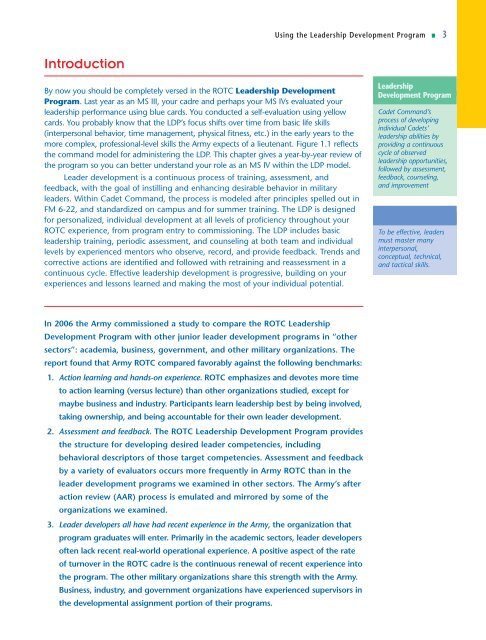using the leadership development program - UNC Charlotte Army ...
using the leadership development program - UNC Charlotte Army ...
using the leadership development program - UNC Charlotte Army ...
You also want an ePaper? Increase the reach of your titles
YUMPU automatically turns print PDFs into web optimized ePapers that Google loves.
Using <strong>the</strong> Leadership Development Program ■ 3IntroductionBy now you should be completely versed in <strong>the</strong> ROTC Leadership DevelopmentProgram. Last year as an MS III, your cadre and perhaps your MS IVs evaluated your<strong>leadership</strong> performance <strong>using</strong> blue cards. You conducted a self-evaluation <strong>using</strong> yellowcards. You probably know that <strong>the</strong> LDP’s focus shifts over time from basic life skills(interpersonal behavior, time management, physical fitness, etc.) in <strong>the</strong> early years to <strong>the</strong>more complex, professional-level skills <strong>the</strong> <strong>Army</strong> expects of a lieutenant. Figure 1.1 reflects<strong>the</strong> command model for administering <strong>the</strong> LDP. This chapter gives a year-by-year review of<strong>the</strong> <strong>program</strong> so you can better understand your role as an MS IV within <strong>the</strong> LDP model.Leader <strong>development</strong> is a continuous process of training, assessment, andfeedback, with <strong>the</strong> goal of instilling and enhancing desirable behavior in militaryleaders. Within Cadet Command, <strong>the</strong> process is modeled after principles spelled out inFM 6-22, and standardized on campus and for summer training. The LDP is designedfor personalized, individual <strong>development</strong> at all levels of proficiency throughout yourROTC experience, from <strong>program</strong> entry to commissioning. The LDP includes basic<strong>leadership</strong> training, periodic assessment, and counseling at both team and individuallevels by experienced mentors who observe, record, and provide feedback. Trends andcorrective actions are identified and followed with retraining and reassessment in acontinuous cycle. Effective <strong>leadership</strong> <strong>development</strong> is progressive, building on yourexperiences and lessons learned and making <strong>the</strong> most of your individual potential.LeadershipDevelopment ProgramCadet Command’sprocess of developingindividual Cadets’<strong>leadership</strong> abilities byproviding a continuouscycle of observed<strong>leadership</strong> opportunities,followed by assessment,feedback, counseling,and improvementTo be effective, leadersmust master manyinterpersonal,conceptual, technical,and tactical skills.In 2006 <strong>the</strong> <strong>Army</strong> commissioned a study to compare <strong>the</strong> ROTC LeadershipDevelopment Program with o<strong>the</strong>r junior leader <strong>development</strong> <strong>program</strong>s in “o<strong>the</strong>rsectors”: academia, business, government, and o<strong>the</strong>r military organizations. Thereport found that <strong>Army</strong> ROTC compared favorably against <strong>the</strong> following benchmarks:1. Action learning and hands-on experience. ROTC emphasizes and devotes more timeto action learning (versus lecture) than o<strong>the</strong>r organizations studied, except formaybe business and industry. Participants learn <strong>leadership</strong> best by being involved,taking ownership, and being accountable for <strong>the</strong>ir own leader <strong>development</strong>.2. Assessment and feedback. The ROTC Leadership Development Program provides<strong>the</strong> structure for developing desired leader competencies, includingbehavioral descriptors of those target competencies. Assessment and feedbackby a variety of evaluators occurs more frequently in <strong>Army</strong> ROTC than in <strong>the</strong>leader <strong>development</strong> <strong>program</strong>s we examined in o<strong>the</strong>r sectors. The <strong>Army</strong>’s afteraction review (AAR) process is emulated and mirrored by some of <strong>the</strong>organizations we examined.3. Leader developers all have had recent experience in <strong>the</strong> <strong>Army</strong>, <strong>the</strong> organization that<strong>program</strong> graduates will enter. Primarily in <strong>the</strong> academic sectors, leader developersoften lack recent real-world operational experience. A positive aspect of <strong>the</strong> rateof turnover in <strong>the</strong> ROTC cadre is <strong>the</strong> continuous renewal of recent experience into<strong>the</strong> <strong>program</strong>. The o<strong>the</strong>r military organizations share this strength with <strong>the</strong> <strong>Army</strong>.Business, industry, and government organizations have experienced supervisors in<strong>the</strong> <strong>development</strong>al assignment portion of <strong>the</strong>ir <strong>program</strong>s.
















